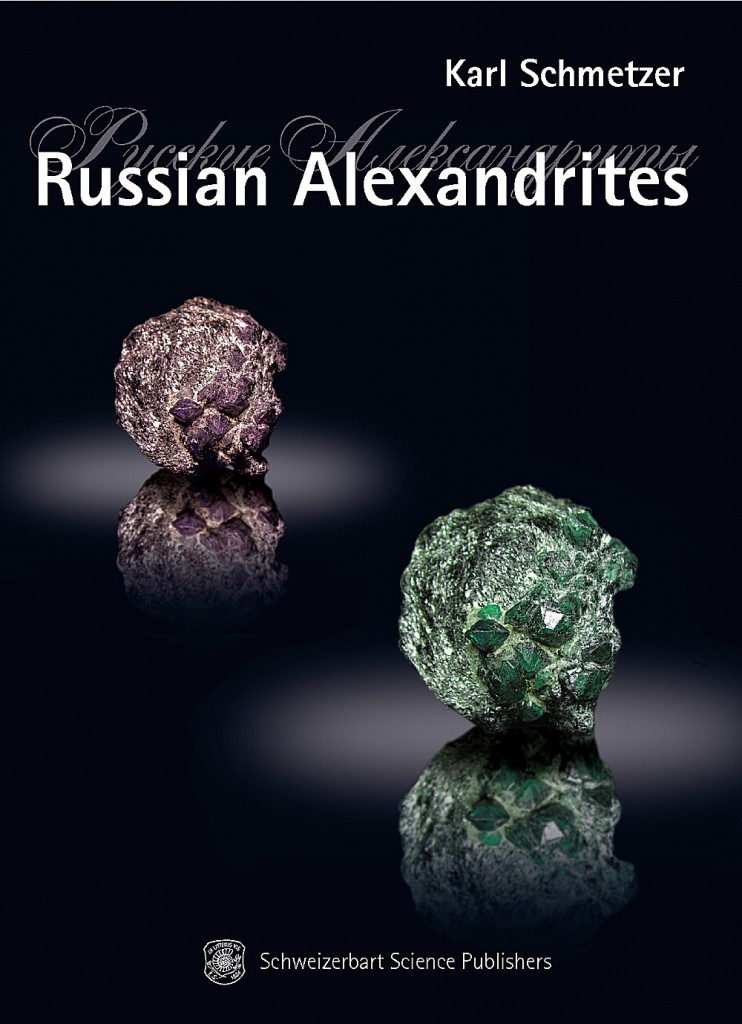Schmetzer, Karl, Russian Alexandrites
2010, 140 pages. ISBN 978-3-510-65264-4 $49.95
by Richard W. Wise, G.G. ©2010
Just received a copy of Dr. Karl Schmetzer’s new book entitled Russian Alexandrites. Schmetzer is the senior author, the book also includes contributions from George Bosshart, Marina Epelboym, Dr. Lore Kiefert and Anna-Kathrin Maisy.
The book begins with an excellent introduction written by Schmetzer and Kiefert detailing the geological setting in the Tokovaya area of the Ural Mountains. Schmetzer notes that in Russia, alexandrite has always been found associated with emerald and gives a comprehensive history of the various discoveries, specific mines and the history of mining for emerald and alexandrite in the area surrounding the Russian city of Ekaterinburg. The introduction includes a breathtakingly beautiful full page image of Russian emerald and alexandrite crystals from the Boyd Collection.
In the Fall of 1830, Maksim Stefanovich Kozhevnikov, a peasant living in the Beloyarsk district discovered the first emeralds clinging to the roots of a fallen tree on the banks of the Tokovaya River. I was immediately struck by the similarity of the description of this discovery of emerald in the Urals to that of the discovery of tourmaline by Elijah Hamlin “on the last day of Autumn” in the same year, at Mt. Mica, Maine. The tourmaline crystals were also found clinging to the roots of a tree: “a vivid gleam of green flashed from an object on the roots of a tree upturned by the wind.” (Hamlin, The Tourmaline, 1873).
Schmetzer also reproduces an entry by mineralogist Sir David Brewster in February 1935 edition of the London Philosophical Magazine and Journal of Science. In the entry, Brewster notes that the crystal is pink-red under candlelight that a thicker crystal would be redder and redder. This entry, read a certain way, is a misleading description and may be the actual source of largely mythical “ruby red” alexandrite. Another other possible source, a novel, The Alexandrite, written by Leskov and published in Russian in 1884 that describes alexandrite as “green by day, red by night.” This, of course, is partly due to the fact that in 1830, incandescent illumination was limited to candlelight which at 1500 kelvin is a good deal redder than the light bulb at 3200k.
Chapter 4 surveys the location of important collections of alexandrite specimens and includes photographs of some of the finest examples. Chapter 5 contains an excellent, easy to understand and beautifully illustrated using both drawings and photographs of actual specimens, discussion of alexandrite crystal morphology. Chapter 6 examines structural properties, again with excellent illustrations consisting of photomicrographs of crystal slices that show both growth patterns and pleochroism. Chapter 7 discusses the very rare cats-eyes and star stones. Chapter 8 compares growth patterns between Russian, synthetic and other natural sources of alexandrite including a suggestion about crystal habit that could be useful to gemologists and dealers in the field in doing preliminary separations of Russian versus alexandrite from other locations using magnification alone.Chapter 9 is the least satisfying though it does have an interesting discussion of color and crystal orientation that would be of interest to lapidaries.
Chapter 10 discusses origin determination. Branding is rampant in the gem trade. High dollar premiums are regularly paid for sapphires from Burma and Kashmir and tourmalines from Paraiba (Rio Grande do Norte) Brazil. Russian alexandrite, due to its very limited supply, enjoys a mythical and mostly undeserved status in the gem trade (Wise, Secrets, p.85-89). Using Laser Ablation (LA-ICP-MS) a particularly sensitive instrument that uses a laser to excise a tiny bit of material and subject it to X-ray fluorescence spectrometry (EDXRF) is able to compare tiny concentrations of trace elements. Schmetzer compares alexandrite from several sources, Hematatita Brazil, India and Lake Manyara, Tanzania and Russia. The study concludes that relative concentrations of the elements; B, V, Ga, Ge, Sn and Ta are relevant in differentiating point of origin in alexandrite. The study was not exhaustive as it excludes material from Ilakaka, Madagascar as well as some other minor localities. It does, however, form a strong foundation to build upon.
The book also includes an appendix with a list of the principle Russian mines and a useful historical timetable. There is an extensive bibliography and index. Altogether a very satisfying volume and a necessary addition to every gemological library. Unfortunately like other German publications, the book is not available on Amazon or any other online easily accessible source. The book may be purchased by contacting the publisher; Schweizerbart Science Publishers. for our English readers, the book also available through the GemA bookshop.

